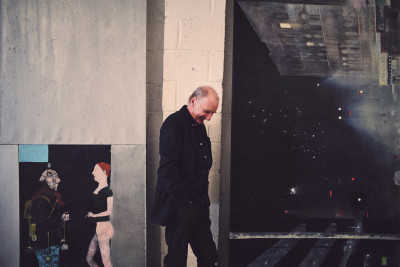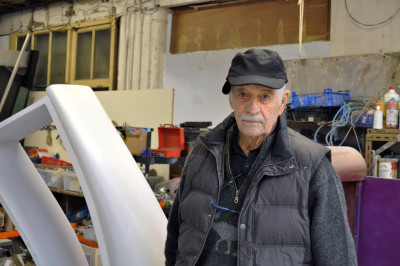10 minutes with… Phillip King PPRA
10 minutes with… Phillip King PPRA
By Harriet Baker
Published 1 December 2014
Each month, we have a quick chat with one of our Academicians to find out what they’re up to and what the RA means to them.
-
The internationally renowned sculptor and Past President of the Royal Academy has an ever-evolving sculptural style, from traditionally figurative to robust and abstract. This year, he will be showing new work at Tate Britain to celebrate his 80th birthday. He works from his studio in West Hampstead.
-
What are you working on at the moment?
I’ve been working a piece which I call Recoil, which was triggered by a filmmaker, called Gerald Fox, who decided to make a film about my work. He was following me around in the studio, and so I thought it might be interesting for him to see me make a work from scratch.
I didn’t know what I was going to do, but I started working on a model and he started filming. My method of working is to feel my way to the idea. Sometimes it jumps in your head, at other times it takes a lot of manoeuvring. There was a green element I knew I wanted to use, and that was about it, and it went through about fifty or sixty stages before I started working on a much larger scale. The piece is the result of the film being made. As the film was going on, I was unloading my ideas, in order to make an informative piece about how I work as a sculptor.
-
How do you know when a work is finished?
Lots of my work is made out of found objects that I’ve picked up from the street, or I’ve had lying around in the studio. Some works can take ten years to finish. I started a work called Red Between in the 1970s, and I finished it and moved on to other things. A few years later I realised there was something wrong with it. There was something about it that I was unhappy with and so I changed it considerably. A work becomes like a character, and it has to have a personality that you recognise. I rely on a subconscious dialogue about what I like and what I dislike in a work, and gradually I come to like more and more what’s there.
-
What is your earliest memory of art?
My mother was French Algerian and she collected paintings, including one by Albert Marque after he married a friend of her sister’s. It was a portrait of Algiers. Later, he came to stay with us and there are paintings of his that were made looking out from where we lived. I could recognise the landscape.
I wasn’t encouraged to become an artist in any way, and I did it in spite of my father encouraging me to do something else. I studied Russian literature at Cambridge University and in my second year became more and more involved with sculpture. I found a basement in a street near my college and I just started working.
-

Phillip King, Genghis Khan, 1963/2014.
Steel. Offered by Thomas Dane Gallery.
-
What work of art do you wish you’d made?
If you could magically put yourself into the skin of another artist doing some work, that’s one question; but the work you admire the most? Quite another! I wouldn’t mind being Michelangelo for a while. But actually I don’t think I would, because he was agonised. I would have like to have been carver on a cathedral in the medieval times.
I admire the work of Constantin Brancusi, especially his Endless Column. But I don’t think it would have been pleasurable to make because it would have been so hard going. Some works are enjoyable and successful, but some are difficult to make and cause you great problems – and may not necessarily be great either. It’s very strange how things can go.
-
Where were you when you found out you had been elected?
I don’t remember that. I was a very reluctant RA to begin with. In those days, the Academy didn’t have to reputation it does today. Bryan Kneale RA was a good friend and he persuaded me to join. He had an exhibition at the RA [British Sculptors ‘72] and it was a breakthrough in the showing of sculpture. I was given a room and I made a piece called The Academy Piece, which I am still in love with today. I came to love the RA more and more, but it took some getting used to.
-
What does the RA mean to you?
I have admiration and respect for the RA because it has survived all this time intact with all its different elements. It’s a bizarre institution in many ways, with all these artists that pull off in different directions, though they still make it function. It’s a contradiction, but that’s its beauty. It’s a very established and loved institution in this country, which finds great sympathy in its Friends.
-
If you were President again for the day, what would you change?
I don’t think it would be very diplomatic for a Past President to answer this! I would like to see a foreign artist take residency in Burlington Gardens, bringing in exciting artists from other parts of the world into the Academy in order to work there. I would give them a space in which to work for a period of time and then a small exhibition at the end, opening up the RA to the rest of the world a bit more.
-
Who would you like us to interview next?
Richard Wilson RA. I think he’s a great character and he’s full of life, and he’s often up to surprising and exciting things.
Phillip King PPRA will show work in the Duveen Galleries at Tate Britain.




